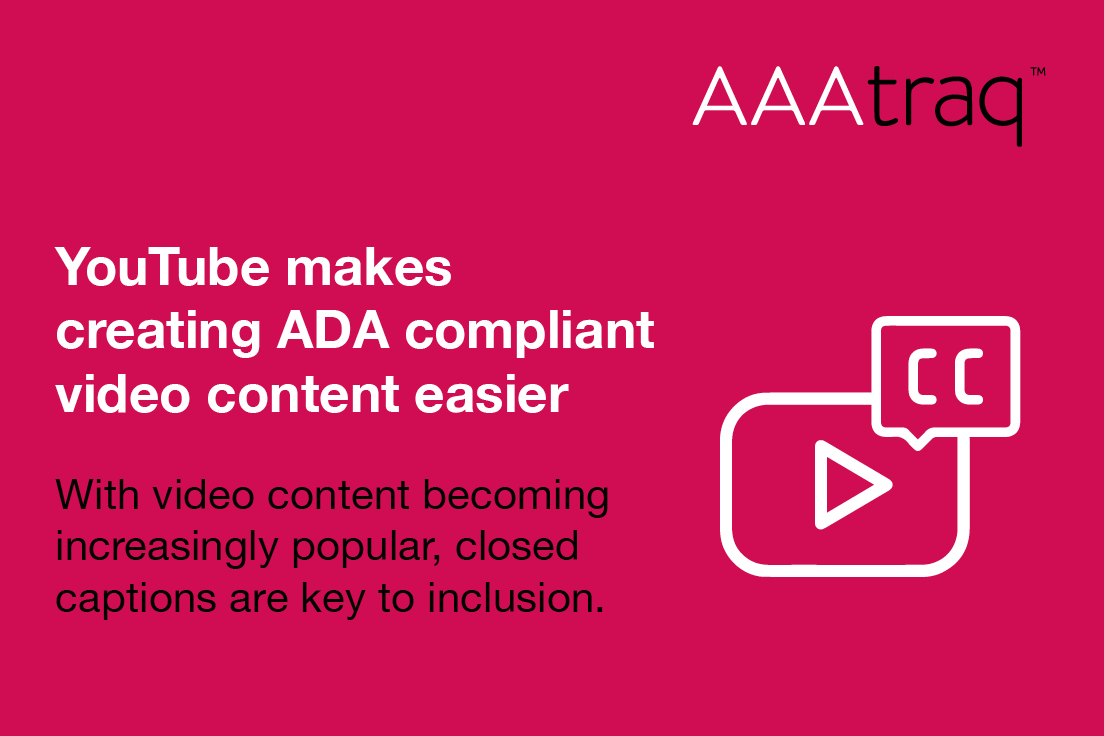YouTube makes creating ADA compliant video content easier
Aug 24 2021
In today’s digital first world, video content has become increasingly popular for marketing and communication purposes, and is an easy way to convey information.
Lemonlight1 released some statistics earlier this year showing just how popular and influential video content is in 2021.
- Viewers claim they retain 95% of a message when obtained via video
- 94% of video marketers say video has helped increase user understanding of their product or service
- 78% of marketers say video has directly helped to increase sales
- 99% of marketers claim they will continue to use video in their approach
However, things aren’t always so easy when it comes to video content for people living with disabilities, including people who are deaf or hard of hearing, which is where closed captions come in.
What are closed captions?
To ensure video content is inclusive and adhering to accessibility guidelines, closed captions or subtitles should be included on all videos. Captions aren’t just the words that are spoken, it is also things like a description of a song being used as background music, and other sounds such as laughter.
By using closed captions, it will assist multiple users. For those who are deaf or hard of hearing and cannot hear some, or all of the audio, it will enable them to understand the audio content. It will also help those with cognitive and other disabilities who find captions useful to comprehend the content.
Captions can also be beneficial in loud situations or one where sound cannot be used. A recent VerizonMedia and Publicis Media report (opens in a new window) states that 69% of people report viewing videos without sound in public places and 25% of people report viewing videos without sound in private places. They also report that 80% of those who use captions aren’t deaf or hard of hearing. This clearly shows that captions have their place for all users, regardless of whether they have accessibility requirements or not.
The rise in website ADA compliance litigation cases has been well documented, and these cases have often been focusing on video content missing closed captions. San José Spotlight reported in June that Several South Bay businesses has been sued for lack of closed captions. (opens in a new window)
How to add closed captions using YouTube
Most video hosting sites have the facility to automatically generate captions, however this service isn’t entirely reliable. Where the speaker has a regional accent or there is competing audio (e.g. background music) within the clip, accuracy can be impacted. Content creators can, and for the best accessibility results should, include their own captions when uploading video content.
YouTube, which has 2+ billion users2, has made it easier for content creators to upload their own captions. In July 2020, they launched a new captions editor and in May 2021, added the ability to add captions during the upload process to incentivise content creators to caption their own videos.
Captions can be typed or can be uploaded in the form of a document (.txt file) - with or without timings. To find out more about how to add captions to your videos, please visit the YouTube Support Pages (opens in a new window). If captions are uploaded by the content owner, YouTube will also show this on their channel with a ‘subtitles’ icon below the videos.
Adding captions to your video content has many benefits. It improves the experience for people living with disabilities and makes content accessible, helping towards ADA compliance and reducing the risk of litigation. Closed captions also helps with SEO as video content that includes captions, can be better indexed by search engines.
1https://www.lemonlight.com/blog/67-video-marketing-stats-you-need-to-know-for-2021/ (opens in a new window) 2https://blog.youtube/press/ (opens in a new window)
Subscribe to AAAtraq and enjoy complete cover and peace of mind
